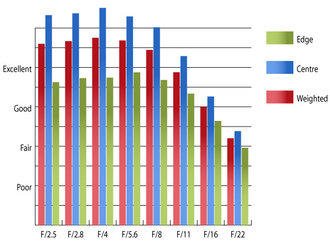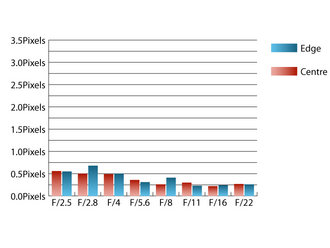Panasonic 14mm f/2.5 Lumix G Lens Review
Panasonic 14mm f/2.5 Lumix G Performance
Sharpness is already outstanding in the centre of the frame at a maximum aperture and the quality towards the edges is very good. The quality across the frame improves slightly as the lens is stopped down, with the quality towards the edges almost reaching excellent levels by f/5.6. Stopping the lens down further reduces sharpness due to the effects of diffraction, but resolution levels are still good across the frame down to f/11. Resolution at 14mm | How to read our chartsThe blue column represents readings from the centre of the picture frame at the various apertures and the green is from the edges. Averaging them out gives the red weighted column.The scale on the left side is an indication of actual image resolution. The taller the column, the better the lens performance. Simple. For this review, the lens was tested on a Panasonic Lumix G3 using Imatest. |
Levels of chromatic aberrations are low, and should pose few issues, even in large prints and harsh crops from the edges of the frame. At wide apertures CA levels just exceed half a pixel width but diminish as the lens is stopped down.
 Chromatic aberation at 14mm | How to read our chartsChromatic aberration is the lens' inability to focus on the sensor or film all colours of visible light at the same point. Severe chromatic aberration gives a noticeable fringing or a halo effect around sharp edges within the picture. It can be cured in software.Apochromatic lenses have special lens elements (aspheric, extra-low dispersion etc) to minimize the problem, hence they usually cost more. For this review, the lens was tested on a Panasonic Lumix G3 using Imatest. |
As falloff and distortion are corrected by the camera's image processing engine when shooting JPEGs, Falloff and distortion will only be easily visible when shooting in RAW format.
Falloff of illumination towards the corners of the frame is reasonably prominent, with the corners being 2.03 stops darker than the image centre at f/2.5. Visually uniform illumination is achieved when the lens is stopped down to f/4 or beyond.
Barrel distortion is reasonably strong for a prime lens with Imatest recording 1.51% barrel distortion. This level should pose few problems, but if your application demands straight lines, you'll be glad to know that the distortion pattern is uniform across the frame, which should make any corrections straightforward.
Flare can be an issue when shooting into the light, with flare being quite prominent and contrast levels dropping. With light sources outside the frame, this lens is much more resilient.
Add your message
Login required
Please login here or if you've not registered, you can register here. Registering is safe, quick and free.
Please login here or if you've not registered, you can register here. Registering is safe, quick and free.
photodo Stats
1102 lenses
428 MTF tests
74 in-depth photodo reviews
100+ users join each day
Help the lens community by reviewing or rating a lens today via our lens search
428 MTF tests
74 in-depth photodo reviews
100+ users join each day
Help the lens community by reviewing or rating a lens today via our lens search
Latest Lens Reviews
- Chinon 28mm f/2.8 Vintage Lens Review
- Canon EF 70-200mm f/4L IS II USM Lens Review
- Samyang AF 85mm f/1.4 EF Review
- Sigma 70mm f/2.8 DG Macro Art Review
- Samyang AF 24mm f/2.8 FE Review
- Meike 50mm f/1.7 Review
- Tamron 70-210mm f/4 Di VC USD Review
- Lensbaby Burnside 35mm f/2.8 Review
- Asahi Super Takumar 50mm f/1.4 Review
- Asahi Super-Multi-Coated Takumar 135mm f/3.5 Review
